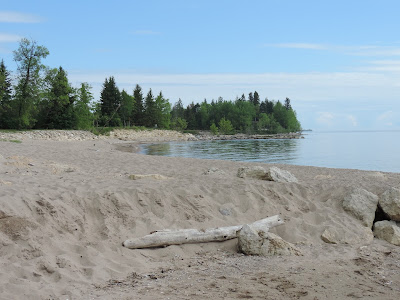When I was a boy, I had a vivid imagination. Some might have even called it overactive. It found expression in many ways and my parents, along with our neighbors, encouraged it, as long as it didn’t stray in the direction of fabrication.
Long before our family owned a car, my father began replacing our potholed asphalt driveway with concrete. He did it a patch at a time, cutting away the failed asphalt down to the gravel base and replacing it with concrete that he mixed by hand in a wheelbarrow. Each slab was irregularly shaped and their sizes varied. He tinted each batch of concrete a different color. After pouring each slab, Dad finished the surface with a corn broom for texture and then carefully edged it with a smooth trowel. Over the course of a summer or two, he made his way up each side of the driveway, leaving a remnant of asphalt in the center. The result looked a little like the shape of San Francisco Bay—without the Golden Gate channel. The asphalt was the bay while the concrete was the surrounding landscape, albeit a prairie terrain rather than a mountainous one.
It didn’t take long before I was using the edging as “roads” for my Dinky Toys and Matchbox cars, which fit perfectly along the roadways Dad had created. The textured surface on the rest of each slab made perfect fields, not unlike the wheat fields we passed on the real highways. I had a few hundred miniature vehicles—I was a bit spoiled!—so it didn’t take long for traffic jams to develop around Riverbend Bay as I laid out my toys. It’s a good thing we didn’t have a car to park on the driveway, although I did have a toy or two crushed by vehicles turning around at the end, seemingly unaware that this particular driveway was alive with imaginary people and places.
Stories unfolded in my imagination as I drove my vehicles up and down the roadways. There were wars and disasters, deliveries and country drives—every conceivable circumstance that a youngster’s imagination could dream up. I spent hundreds of hours in this landscape, my imagination running wild. I’m 60 now, but I still keep some of those toys I played with when I was six in a box downstairs, and whenever I take them out, my imagination still overflows.
I graduated eventually from toy cars to a paper route, but that didn’t interfere with my imagination. Delivering papers is boring work, so there was plenty of time to think as I pulled my wagon filled with newspapers from house to house. Along the way, I would talk to myself out loud, sing or whistle, and keep my mind occupied by letting it drift to other places. Some of my customers would just shake their heads as their daydreaming, tow-haired paperboy meandered along the street—usually late—delivering the day’s news. Other customers actively engaged my imagination, encouraging my storytelling and singing, playing along with me when they could.
The curious thing in all of this is that I grew into who I am through the unfettered growth of my imagination. Looking back, I realize that the values I treasure were shaped through my imaginary wanderings as a child and refined through my experiences as an adult. But whoever it is that I am today, that person can be glimpsed in a boy who played on the driveway and delivered papers. If I am impatient with the world as it is, it is only because I learned to dream of a better world as a child. And I’ve never ceased believing that the world of our dreams could become a reality if we pursued our dreams with imagination instead of caving in to so-called common sense and practicality.
In The Conduct of Life, Ralph Waldo Emerson wrote: “We live by our imaginations, by our admirations, by our sentiments. The child walks amid heaps of illusions, which he does not like to have disturbed.” I agree that we live most fully when we live by our imaginations, and I acknowledge that, as a child, I was surrounded by heaps of illusions. But if my imagination and illusions have been disturbed, it’s only because, as adults, we allow ourselves to become disenchanted and estranged from our imagination, which happens to be where our better angels reside.
Imagination, whatever our age and circumstances, is vital.
Which is why I am so excited to see a new leadership team come on board at the CLF. The board and the search committee were bold in imagining the CLF’s future—a future that responds to the urgent call of justice that we feel in the present moment. They were bold in imagining ministry as something that goes beyond those who are ordained, and chose a leadership team that includes two religious educators as well as an ordained minister. And I am so eager to see what the vivid imaginations of the CLF’s new lead ministry team—Aisha Hauser, Christina Rivera and Michael Tino—will bring us as we imagine the future together.
Attached media: https://web.archive.org/web/20211110172715/https://www.questformeaning.org/podcasts/20_09/04.mp3






